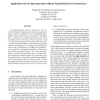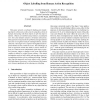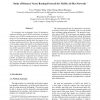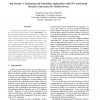PERCOM
2003
ACM
14 years 8 months ago
2003
ACM
Passive RFID technology and unobtrusive Bluetoothenabled active tags are means to augment products and everyday objects with information technology invisible to human users. This ...
PERCOM
2003
ACM
14 years 8 months ago
2003
ACM
To programmatically discover and interact with services in ubiquitous computing environments, an application needs to solve two problems: (1) is it semantically meaningful to inte...
PERCOM
2003
ACM
14 years 8 months ago
2003
ACM
This paper presents a method for finding and classifying objects within real-world scenes by using the activity of humans interacting with these objects to infer the object’s i...
PERCOM
2003
ACM
14 years 8 months ago
2003
ACM
The paper describes research that has been carried out in “extrovert-Gadgets”, a research project funded in the context of EU IST/FET proactive initiative “Disappearing Comp...
PERCOM
2003
ACM
14 years 8 months ago
2003
ACM
Seeking to extend the functional capability of the elderly, we explore the use of probabilistic methods to learn and recognise human activity in order to provide monitoring suppor...
PERCOM
2003
ACM
14 years 8 months ago
2003
ACM
We investigate the performance issues of destinationsequenced distance vector (DSDV) and ad-hoc on-demand distance vector (AODV) routing protocols for mobile ad hoc networks. Four...
PERCOM
2003
ACM
14 years 8 months ago
2003
ACM
As mobile computing becomes common, the battery issue of mobile computing devices has become increasingly notable. To this end, research and development of various power-conservat...
PERCOM
2003
ACM
15 years 2 months ago
2003
ACM
Wireless distributed sensor networks (DSNs) are important for a number of strategic applications such as coordinated target detection, surveillance, and localization. Energy is a ...
PERCOM
2003
ACM
15 years 2 months ago
2003
ACM
In pervasive computing environments, powerful handheld devices with wireless connections create opportunities for many new nomadic applications. We propose a new service discovery...
PERCOM
2003
ACM
15 years 2 months ago
2003
ACM
In this paper, we present an advance reservation scheme for CPU and energy resources, called ReCalendar. The goal is to enable soft real-time applications on mobile devices to ach...




